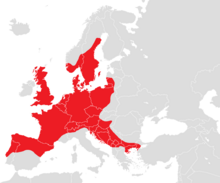
Back Anguis fragilis AN دودة بطيئة Arabic دوده بطيئه ARZ Anguis fragilis AST Cılız koramal Azerbaijani Gloudens BAT-SMG Вераценніца ломкая Byelorussian Вераценьніца ломкая BE-X-OLD Слепок Bulgarian Anuz-dall Breton
| Slow worm | |
|---|---|

| |
| Scientific classification | |
| Domain: | Eukaryota |
| Kingdom: | Animalia |
| Phylum: | Chordata |
| Class: | Reptilia |
| Order: | Squamata |
| Family: | Anguidae |
| Genus: | Anguis |
| Species: | A. fragilis
|
| Binomial name | |
| Anguis fragilis | |

| |
| Range of A. fragilis | |
The slowworm (Anguis fragilis) is a legless lizard native to western Eurasia. It is also called a deaf adder, slow worm, blindworm, or regionally, a long-cripple and hazelworm. The "blind" in blindworm refers to the lizard's small eyes, similar to a blindsnake (although the slowworm's eyes are functional).
Slow worms are semifossorial[2] (burrowing) lizards, spending much of their time hiding underneath objects. The skin of slow worms is smooth with scales that do not overlap one another. Like many other lizards, they autotomize, meaning that they have the ability to shed their tails to escape predators. While the tail regrows, it does not reach its original length. In the UK, they are common in gardens and allotments, and can be encouraged to enter and help remove pest insects by placing black plastic or providing places to shelter such as piles of logs, corrugated iron sheets or under tiles.[3] On warm days, one or more slow worms can often be found underneath these heat collectors. One of the biggest causes of mortality in slow worms in suburban areas is the domestic cat, against which it has no defence.[4]
Slow worms have been shown to be a species complex, consisting of 5 distinct but similar species.
The name "slowworm" does not come from the word "slow". In Middle English it was written "slowurm", from Old English "slāwyrm", where slā- means 'earthworm' or 'slowworm' and wyrm means "serpent, reptile".[5][6] It is related to the Norwegian slo or Swedish ormslå, of same meaning.
- ^ Agasyan, A.; Avci, A.; Tuniyev, B.; et al. (2021). "Anguis fragilis". IUCN Red List of Threatened Species. 2021: e.T47113126A744263. doi:10.2305/IUCN.UK.2021-2.RLTS.T47113126A744263.en. Retrieved 9 June 2022.
- ^ "Feeding state and selected body temperatures in the slow worm" (PDF). Herpetological Journal. 18: 59–62. 2008. Archived from the original (PDF) on 17 June 2009. Retrieved 2009-06-03.
- ^ Vernon, Jean (24 July 2019). "How can I help garden slow worms?". Richard Jackson Garden. Retrieved 26 July 2022.
- ^ "Slow worm | The Wildlife Trusts". www.wildlifetrusts.org. Retrieved 26 July 2022.
- ^ "Slowworm". The American Heritage Dictionary of the English Language. Houghton Mifflin Harcourt. 2017.)
- ^ "Anguis fragilis". The Reptile Database. Retrieved 2021-04-07.
